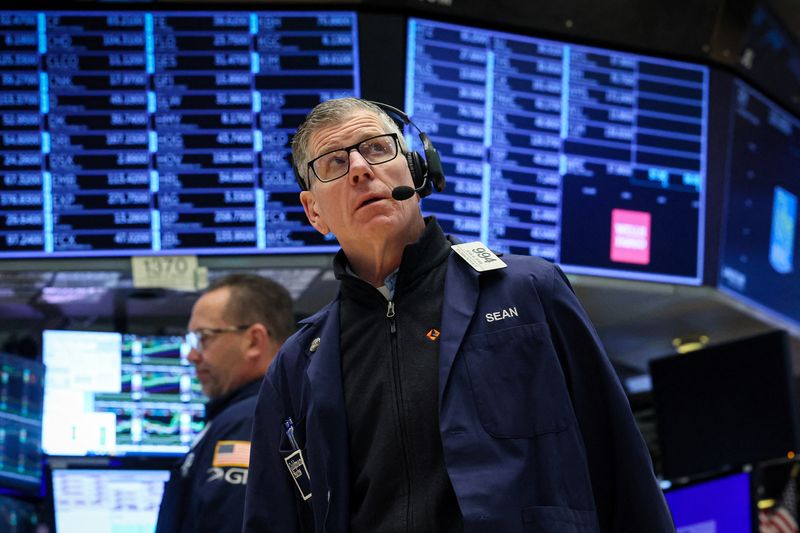By Jamie McGeever
ORLANDO, Florida (Reuters) - The latest figures showing the surprising - some would say alarming - durability of U.S. inflation are also re-focusing the spotlight on the source and strength of demand for U.S. Treasuries.
Bonds are getting crushed and yields are hitting their highest levels in almost six months, as investors scramble to price in the possibility that the Federal Reserve may not cut interest rates at all this year.
Inflation, as measured by the core personal consumption expenditures price index, was 3.7% in the first quarter, well above the 3.4% consensus forecast. The 1.7 percentage point acceleration from the previous quarter was the third fastest rise in more than 30 years.
The two-year Treasury yield leapt back above 5.00% for the first time since November, the 10-year yield is up 50 basis points in under a month, and the bellwether iShares 20+ Year Treasury Bond (NASDAQ:TLT) exchange-traded fund is down 10% this year.
That shows a lot of downward price pressure despite what appears to be still-brisk demand for the paper, and raises questions about who is buying into this.
There is evidence that foreign investors have been stepping up in recent months, although their overall footprint in the Treasuries market is shrinking. U.S. domestic real money, banks and households have not held as large a collective share of the market in more than 20 years, yet bond prices remain under pressure.
It's a murky picture. In some ways, demand for U.S. Treasuries - the world's borrowing benchmark, most liquid market, and top "risk-free" asset - is constant.
But it needs to strengthen if borrowing costs are to stop rising.
"The question is where that demand is going to come from," said Torsten Slok, chief economist and partner at Apollo Global Management (NYSE:APO). "Is it yield-sensitive buyers, meaning domestic households, pension funds, and insurance companies? Or yield-insensitive buyers, meaning foreigners and, if rates go up a lot, ultimately the Fed?"
STRONG TICS
Treasury International Capital (TIC) flows data show that foreigners, including central banks, have increased their holdings for five straight months. Their stash of U.S. Treasuries in February was 8.7% bigger than a year earlier.
Foreign holdings have never been higher in nominal terms, exceeding $8 trillion in the fourth quarter of last year for the first time. That's around 30% of all outstanding U.S. debt, split roughly equally between the official and private sectors.
This is also reflected in recent Treasury debt auctions via the share of "indirect" bids, generally seen as a proxy for demand from foreign investors, especially central banks.
The U.S. Treasury has sold $523 billion of notes this year across 14 auctions, of which indirect bidders have taken up an average 66.8%. Their share has topped 70% in four of these auctions, all of them of a 10-year duration or longer.
Indeed, overall demand at Treasury bond and bill auctions this year has been reasonable. The average bid-to-cover ratio over the 14 bond auctions is 2.52, and over the $629 billion bill in sales across nine auctions it has been 2.92.
YIELD-STARVED
Demand on the secondary market, however, is not keeping up. For yields to stop rising, in an environment of surging post-pandemic supply, the U.S. private sector will have to start buying again in size.
And this is what unnerves analysts and policymakers.
In the near term, the failure of inflation to stay on its downward path towards the Federal Reserve's 2% goal means investors are demanding a higher yield in return. And that's before Washington's gloomy longer-term debt and deficit trajectory is taken into account.
Domestic banks and non-bank institutions hold around $12 trillion, or about 50% of total U.S. federal debt, according to the Committee for a Responsible Federal Budget. Non-banks - mutual funds, pension funds, states and local governments - are by far the largest holders.
But as the Treasury bond ETF swoon shows, bonds are clearly out of favor right now. Bank of America's last fund manager survey also shows the most underweight allocation to bonds since November 2022.
With growth slowing, record stock prices perhaps poised to turn, and the U.S. equity risk premium whittled away to almost nothing, shouldn't investors be snapping up a "risk-free" yield of 5% or higher?
Quincy Krosby, chief global strategist at LPL Financial (NASDAQ:LPLA), says households have been adding Treasury bills and bonds to their portfolios recently but the market needs a "healthy distribution" of buyers.
"Americans have been yield-starved for years. At some point high yields will lead to capital appreciation, and that's what they're waiting for. It doesn't look like we're they're yet though," Krosby said.
(The opinions expressed here are those of the author, a columnist for Reuters.)
(By Jamie McGeever; Editing by Paul Simao)
